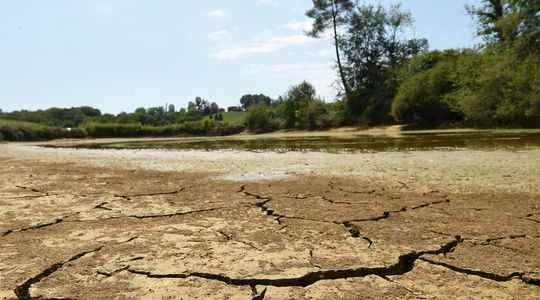In the Plateau des Bornes, in Haute-Savoie, the ballet of tank trucks is incessant. To fill the water reservoirs, which have been dry for three weeks, dozens of machines parade, loaded with up to 12,000 liters each. Because drinking water is lacking in nearly a dozen municipalities on the plateau. This has led to cuts and the implementation of many restrictions, including the ban on watering, or even irrigating for farmers. A situation far from unprecedented.
Traveling to Roumoules (Alpes-Maritimes), Friday, the Minister of Ecological Transition Christophe Béchu alerted to the “historic” situation that the country is going through. “More than a hundred towns in France today no longer have drinking water,” he said. In these municipalities, said the minister, “there are supplies that are made with drinking water trucks that are transported (…) since there is nothing left in the pipes”.
Nearly depleted water sources
This unprecedented drought situation in France since 1959, according to data from Météo France, is linked to a lack of precipitation in the fall and last winter. To qualify this drought, Andréassian Vazke, hydrologist, has been measuring the flow of dozens of rivers in France with his teams since the start of the summer period. “Compared to their average in normal times, these flows today are very low, he reports to L’Express. %”. Added to this is the sequence of three heat waves since May, which lead to faster evaporation of water.
“The water reserves are at their lowest, alarmed Fabienne Trolard, director of research at the National Institute of Research for Agriculture (Inrae). Most regions are in severe water deficit. In Provence-Alpes- Côte-d’Azur, it has a 78% water deficit”. As proof: the water level of the lake of Serre-Ponçon (Hautes-Alpes), located upstream of the Durance and which recharges a good part of the region with water, is seven meters below its average level for the period.
The only way to recharge our general water reserves: rain. But according to the weather forecast, it is not expected in abundance in the coming weeks. “The drought will continue until the rains resume, comments Andréassian Vazke. For the 1976 drought, the rains did not return until the end of September – beginning of October. But this is not the first rain that the sources are recharged”. According to him, the number of municipalities affected by water cuts could thus increase. “Without precipitation, it is inevitable. There could easily be nearly 200 municipalities in lack of water at the end of the month”. By mid-August, “it is very likely that this drought of the soil will worsen further in a large number of regions”, warned, on Friday, Météo-France, which expects a further rise in temperatures.
Large cities rather spared
The southeast, east and Brittany are the territories most affected by these events. Nevertheless, Andréassian Vazke observes that “these are in particular small municipalities, which are generally supplied with a small source or a small water table. And in times of drought, it is not uncommon for them to dry up , both because they are more busy than in winter but also because their surface area is smaller”. An observation shared by Fabienne Trolard, of Inrae: “Big cities have more resilient water resource systems. This does not prevent reserves from being very low.”
In Paris, for example, “the water reservoir dams could only be filled to 90% because of the drought, reports hydrologist Andréassian Vazke. Even if the filling was not carried out in full, it is very unlikely that Paris will run out of water, because the system is relatively well done. Moreover, the pumping restrictions decreed in many departments are made so that the water level stops falling and that the communes can to serve.”
“Everyone should save water”
Friday August 5, Elisabeth Borne announced the activation of an interministerial crisis unit, in order to coordinate the means of the State in the face of the period of “exceptional drought” that France is going through. “The state of water resources is closely monitored to trigger water use restrictions at the right time and gradually in order to guarantee the exercise of priority uses of health, safety, public sanitation, going as far as measures to ‘prohibition at the crisis level’, explained the Ministry of Ecological Transition to Agence France-Presse.
“All the current restrictions are aimed at not cutting off drinking water for taxpayers”, explains Andréassian Vazke, while domestic consumption represents only 24% of its use, compared to 48% for agriculture and 22% for energy. “Everyone must save water, adds Fabienne Trolard. We must proceed to a change of mentality because these phenomena of drought will multiply in the coming years.”
According to scientists’ forecasts, these water shortages could increase, “especially around the Mediterranean basin, which is estimated to be drying up”, notes Frédéric Hourdin, climate physicist and research director at the CNRS. . “In 20 years, the heat wave of 2003 and that of today will be average summers in terms of climate. And the heat waves will be much more above that. Hence the importance of changing our behavior but also adapt,” he concludes.
